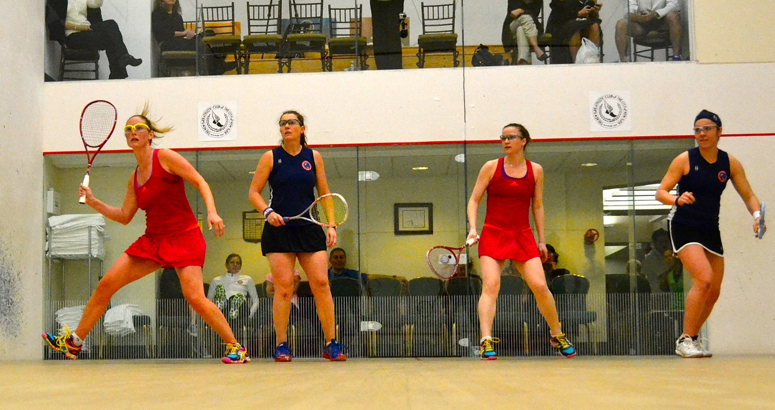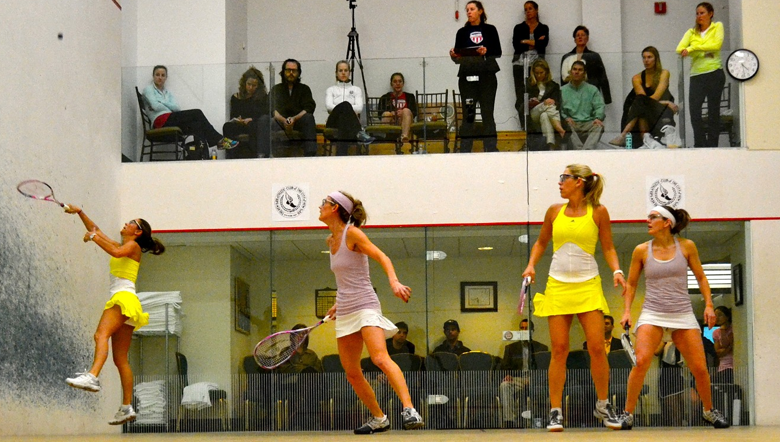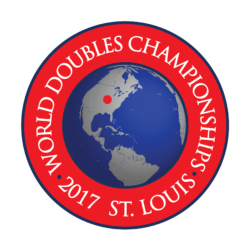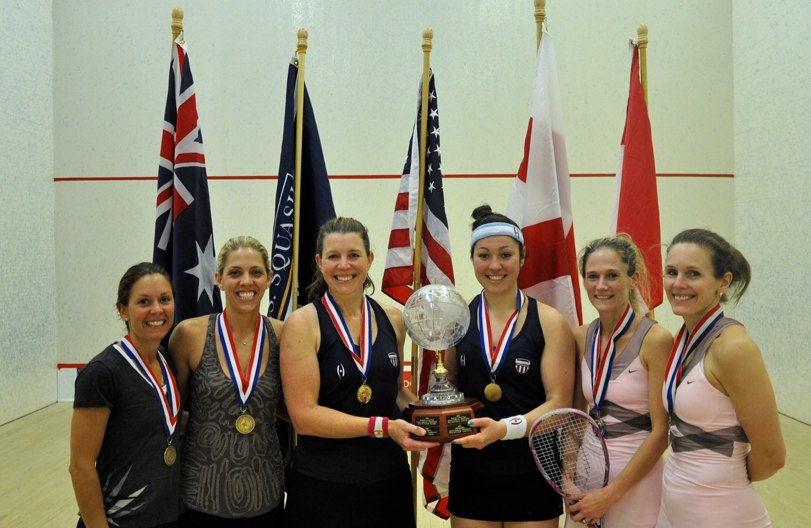The pair, who just weeks ago played against each other for the individual title of 2013 U.S. National Champion in the 2013 U.S. National Championships women’s final, were this time competing as a doubles team together against Canadians Seanna Keating and Stephanie Hewitt.
In the finals match, held at Brooklyn Heights Casino, the top seeded Grainger/Sobhy team comfortably defeated the number two seeds and defending champions Keating and Hewitt in three games, 15-7, 15-11, 15-7, to take out the title of Turner Women’s Open World Doubles Champions.
In the play offs for third and forth place, Australia’s Narelle Krizek and Natarsha T. McElhinny defeated England’s Tina Rix and Carrie Hastings in five games.
Tracy Gates, a passionate squash fan and player who lives in New York City and writes about squash on her blog, Squeaky Feet, gives her account of the final…
___________________
Guess Who’s Invited to the Turner Cup Finals
I think I can tell you this. Amanda Sobhy likes her fusilli with tomato sauce and her salad with dressing on the side, and more than that I cannot say, or I may never be invited for dinner along with Amanda, or any other pro squash player, yet again. The dinner was quite last minute and definitely down time for Amanda, but as I had earlier that evening witnessed her and her partner Steven Scharff’s impressive five set loss in the mixed-doubles quarter finals to number two seeds, Stephanie Hewitt and Viktor Berg, I couldn’t help wishing we were on record. What if Sobhy made it to the women’s finals with her partner Natalie Grainger? But I kept my mouth shut, and three days later, Sobhy and Grainger are in the finals for USA.
Coincidentally, Stephanie Hewitt is also in the finals with her partner Seanna Keating, representing Canada. She and Keating look like they could be sisters or cousins; they’re both strong but very slim. In their light pink dresses, they remind me of fine-boned flamingos. But looks are often deceiving, especially in sports, and Hewitt, currently a world number one doubles player with the WSDA, is one of the fittest and smartest players I’ve yet to watch.
I can’t help wondering, though, how these women will hold up against the impressive physicality of Sobhy and Grainger. This USA team is all about power, that is until they show you their technique. They may not have the on-doubles-court experience of Hewitt and Keating, but they’re both mentally as well as physically strong. And with every point throughout the weekend, Sobhy looks more and more comfortable on court.
The court she needs to relax into for the finals is at Brooklyn’s Heights Casino, tucked below ground level. It features a small side entry door and fairly high ceilings, with just two crossbeams to strategically avoid. A member clues me in that the one toward the front is actually a kitchen duct. The packed house watches from stands at the back looking down into the court, and I grab a good perch above the right rear corner just before the first serve by Grainger.
By now, I know that the first point or so is often run on nerves and adrenaline, although some of that may be mine. Grainger, however, is probably past that. She trades a few lobs with her opponents and then lays down her first of many volleys into the left corner, essentially saying that she means business. Sobhy follows her teammate’s lead and drops for the next point. To which Grainger answers with another decisive and powerful corner. Hewitt, probably smelling her own blood in the air, tries for a drop from the back but hits tin, and it’s not until Grainger tins a forehand volley that Canada gets on the scoreboard at 4-1 USA. And while Grainger may be completely comfortable, Sobhy is still settling in. She actually double faults on her serve at 5-1, giving Canada a second point. But USA doesn’t give away much in this game after that. Sobhy retrieves as well as anyone I’ve seen and blasts her forecourt shots so hard that often Keating and Hewitt barely have time to flick their racquets out. And while I’m sure they are expecting Grainger’s repeated killer shots to the left corner, there seems to be nothing they can do about it; if the ball is anywhere near Grainger’s wheelhouse and the timing seems right, she puts it into the corner for a sure point. Only at game point, 14-6 USA, does she make an error, going back for a retrieval and calling ‘got it’ right before she misses it. But Grainger picked the right partner; Sobhy gets a reverse corner for the win. 15-7 USA.
Game two starts off with a similar pattern. Canada gets the first point, but between Sobhy’s rapid fire returns and Grainger’s accurate shooting and high lobs, Keating and Hewitt can’t apply any of their own pressure; they’re basically in retrieval and survival mode. The chances they do take keep hitting tin. Grainger takes over the serve at 2-1 and her run doesn’t end until seven points later. And the point after that, she runs to cover the back for Sobhy and narrowly misses the off-course trajectory of Sobhy’s last-moment retrieval. The partners look a little sheepish for a moment there… but they’re still a comfortable six points in the lead, and then seven when Keating tins the next point. As the next few points pass in an almost blur as Sobhy first puts the ball down the middle for one point, and then down the left past Keating for another, I wonder if the Canadians have any chance at all. It’s 12-3 in the second game and if I were in there, I’d be tempted to just slink off the court. But Hewitt and Keating are far from slinkers and they have enough experience to know that games can change course, as this one begins to when Sobhy hits tin attempting a drop from the back. Grainger tins next, and then Hewitt rescues a drop for another point. Sometimes even a mini run of points can fluster one’s opponents, as Sobhy tins on a reverse right corner, and now the Canadians are definitely back in it.
 But at 7-12 USA, Hewitt and Keating need to continue their run, or get another to actually win this game . . . and it doesn’t help when Hewitt tins going for a cross court drop. Instead, the only successful drop is her hair from its usually tight twist, and she spends a moment tucking it back up. It may also give her a bit of time to re-gather her resolve. She and Keating seem to step further forward in these next few points, pushing the Americans to work harder. Grainger tins the next point, and despite throwing everything she’s got but the kitchen sink at her opponents, she again tins after a particularly admirable display of Phillies, whirlybirds, and skid boasts that make the rest of us go cross-eyed. USA loses the next point quickly and Keating delivers a beautiful drop to bring it to 11-13 USA. I am definitely impressed. The Canadians’ strategy of hitting the ball a bit higher, just over USA’s heads and staying clear of power play at forecourt is clearly working. But just as I’m writing this observation down, USA gets the point for game point: 14-11. And then Keating mis-hits her return of serve and gives a little yelp of frustration. All that work for another game loss. I would yell, too. Second game to USA 15-11.
But at 7-12 USA, Hewitt and Keating need to continue their run, or get another to actually win this game . . . and it doesn’t help when Hewitt tins going for a cross court drop. Instead, the only successful drop is her hair from its usually tight twist, and she spends a moment tucking it back up. It may also give her a bit of time to re-gather her resolve. She and Keating seem to step further forward in these next few points, pushing the Americans to work harder. Grainger tins the next point, and despite throwing everything she’s got but the kitchen sink at her opponents, she again tins after a particularly admirable display of Phillies, whirlybirds, and skid boasts that make the rest of us go cross-eyed. USA loses the next point quickly and Keating delivers a beautiful drop to bring it to 11-13 USA. I am definitely impressed. The Canadians’ strategy of hitting the ball a bit higher, just over USA’s heads and staying clear of power play at forecourt is clearly working. But just as I’m writing this observation down, USA gets the point for game point: 14-11. And then Keating mis-hits her return of serve and gives a little yelp of frustration. All that work for another game loss. I would yell, too. Second game to USA 15-11.
What do you do when you’re two games down and your opponents are dousing the small flame you’ve got left? Take what worked in the second game and keep trying, I guess. And observing the lob fest in the first point, that looks to be the case—each team remaining patient for the opportunity to shoot. Keating finally puts the ball low and Grainger can’t sweep it up. Just as Sobhy can’t get to Hewitt’s low lying ball a few points later. Maybe the Canadians just need a full game for their improved strategy to work. But this is a nineteen year old, national singles champion and a recent singles world number one they’re up against. Sobhy tires as fast as a worker ant—which is she doesn’t—and Grainger has strategy and shots imprinted in her DNA by now. At 2-2, they put their game into overdrive and the points fly by as they lob and drop and run all the way to 8-2. Sobhy just misses sweeping up a ball in the forecourt, but they they’re off again with more Philly boasts by Natalie to tire the Canadians even further. Hewitt gets in a lovely reverse corner at 13-4, proving the professional she is, but Grainger blows the next ball right by her to get game and match point. Sobhy tins for 14-5. She misses a cross by Hewitt for 14-6, and then runs hard into Hewitt going for short shot on the right, knocking Hewitt to the floor. That’s got to hurt, and Sobhy is appropriately apologetic. Grainger tins the next ball, giving Hewitt the chance to get her breath back, and in the next point Hewitt goes for a safe lob. Only this one soars just high enough to meet that kitchen duct running across the ceiling. Out of court. Out of time. 15-7 USA and they win 3-0.
Afterward, I finally get a chance to go on record with Sobhy and follow up on a remark she made at dinner, mentioning how much she enjoys doubles. “Why?” I ask. Sobhy smiles happily, as if a kid just come in from a day at the playground. “Because it’s so much fun! It’s so much less stressful than singles, and it’s much more social.” Grainger adds to this enthusiasm. “The (doubles) game just makes sense to me. It’s a lot about power and angles, and it’s helpful that I have a good sense of space. I get on court as much as I can.” If she and Sobhy continue getting on court together, I’m looking forward to seeing the team that could push them to five games, win or lose. And maybe I’ll get another invitation to dinner. . . .


